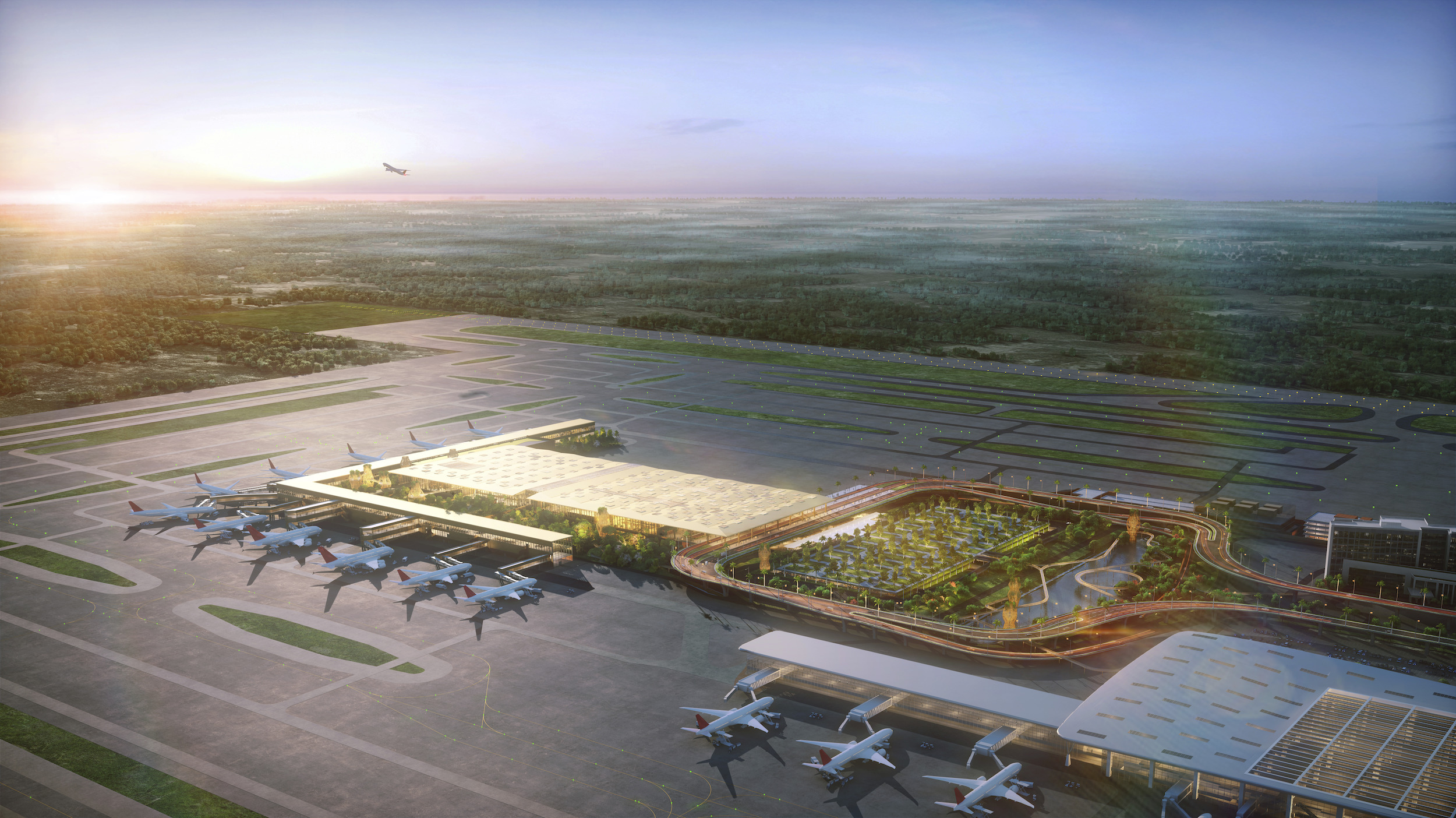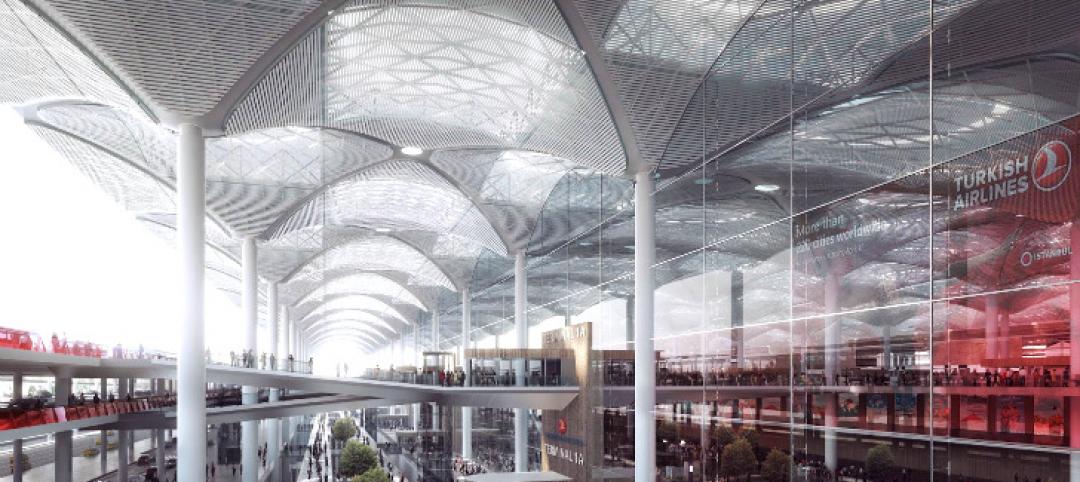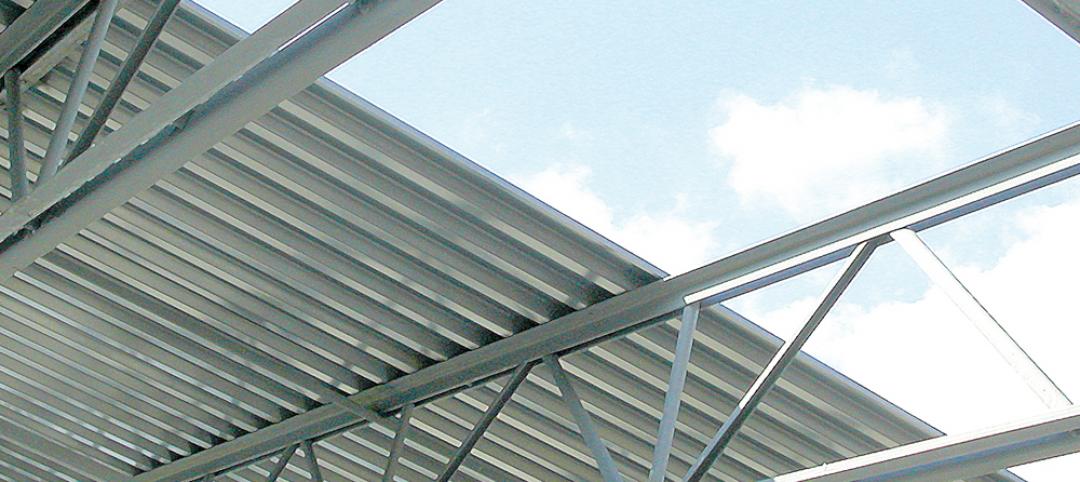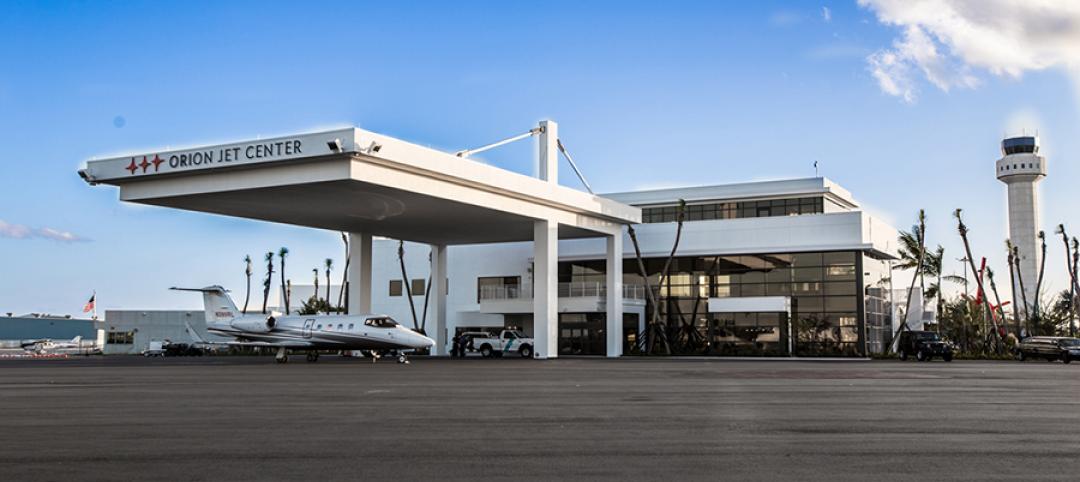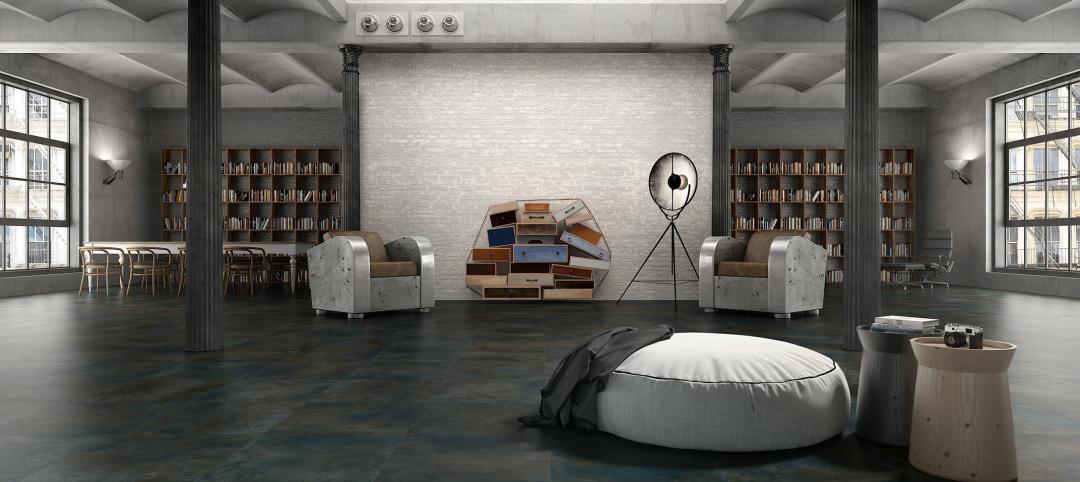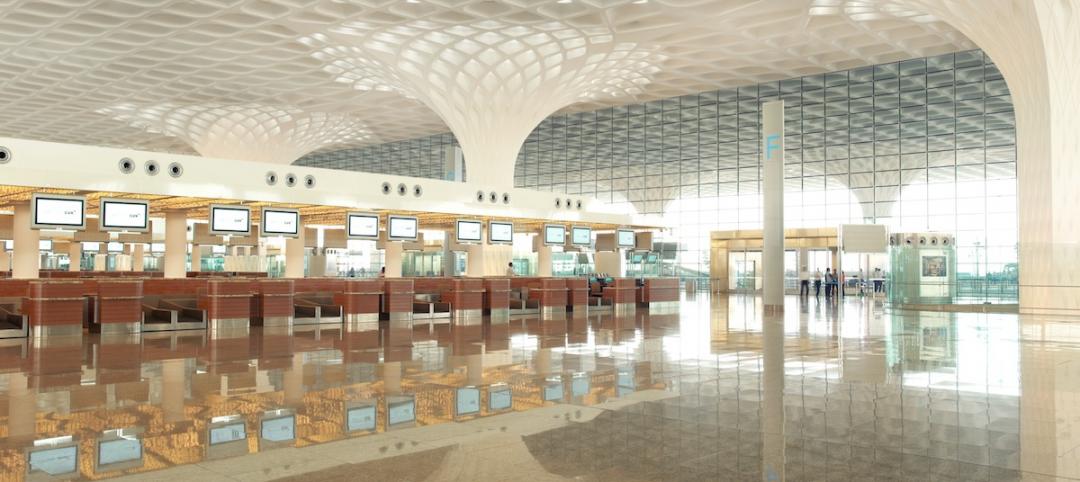Incorporating biophilia into a building’s architectural design has found its fullest expression lately in airports. Setting the bar when it opened in 2019 was the nature-themed Jewel Changi Airport, designed by Safdie Architects, which features an expansive indoor forest and a rain-fed waterfall that, at 40 meters, is the world’s tallest.
On January 15, 2023, Phase 1 of the Kempegowda International Airport’s Terminal 2, in Bengaluru, India, began domestic operations. The 255,661-sm (2.75 million-sf) building, designed by Skidmore, Owings & Merrill (SOM), is projected to process 25 million passengers annually, while providing its travelers with a healthier environment, thanks to extensive indoor-outdoor landscaping that offers serenity to what is normally a frenzied experience.
Phase 1 of Terminal 2 “allows for a sense of wonder and delight” with its outdoor gardens and exotic plants, says Peter Lefkovits, a Partner with SOM, whom BD+C interviewed a few weeks after the terminal opened. The building team on this project included the structural, civil, and facade engineer Buro Happold, which also provided structural and façades engineering services for the Jewel Changi Airport.
Airport terminal offers a natural connection to the outdoors
SOM’s involvement in the Kempegowda Airport project dates back to 2013, when it won a design competition. It worked with Arup on this project's MEP design. Lefkovits recalls that the client, Bangalore International Airport Ltd. (BIAL), “from the get-go” wanted its new terminal to reflect Bengaluru, known locally as the Garden City for its lush parks and gardens, and temperate climate despite being in southern India.
“We give the airport a lot of credit for its vision for a model of sustainability, even pre-pandemic,” says Lefkovits.
Working with the landscape architect Grant Associates and the lighting consultant Brandston Partnership Inc., SOM devised a terminal within a garden that connects passengers to nature. Travelers walking through the airport are exposed to more than 10,000 sm of green walls, hanging plants, and gardens inside a terminal whose buildings are interconnected by a continuous band of outdoor landscaped spaces.
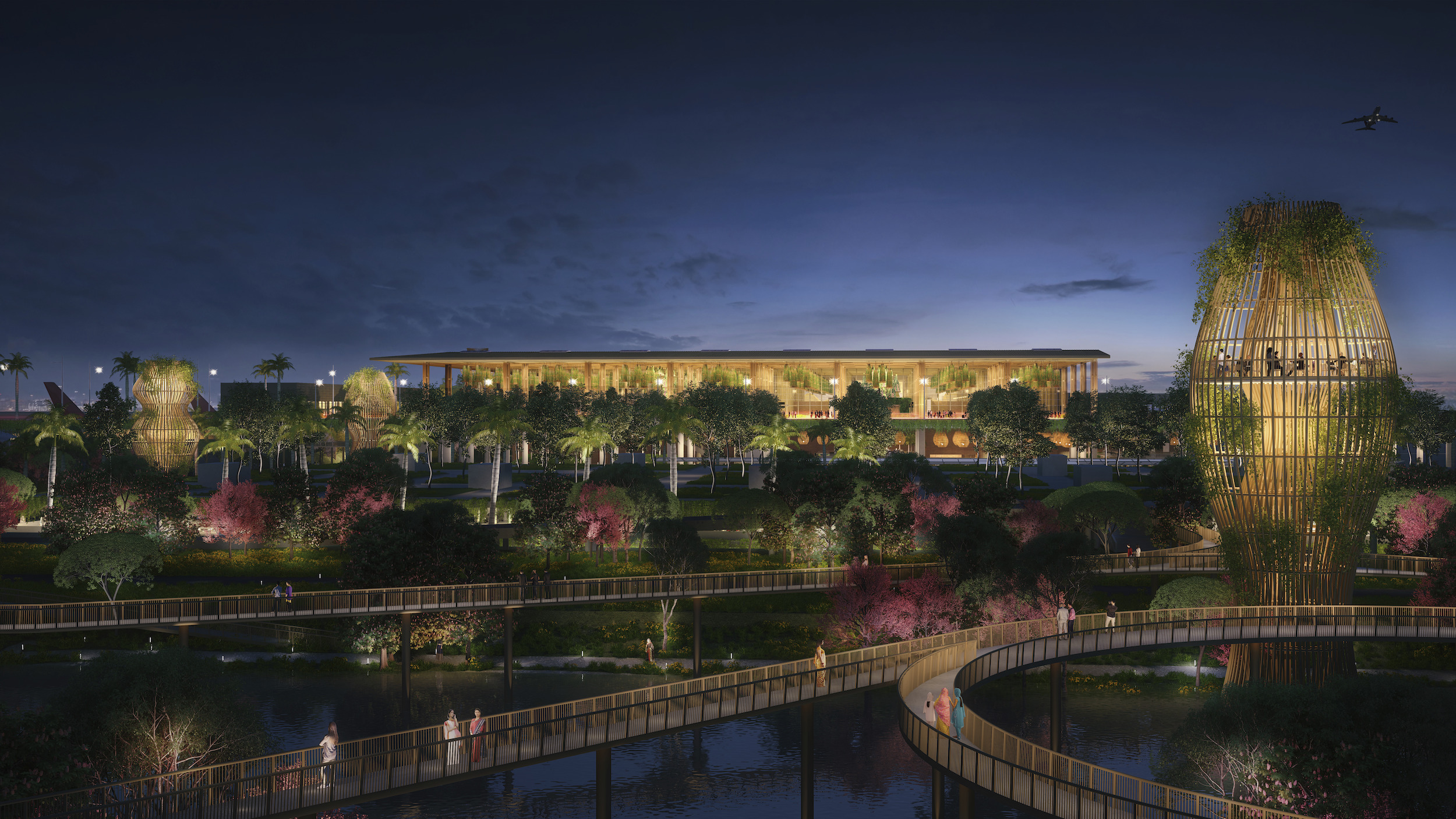
The main complex—which encompasses areas for check-in, baggage dropoff, and security checkpoints—is linked to an 11-gate boarding building by an outdoor, 24,000-sm “forest belt” that rises three stories and includes a series of open-air bridges for departures (upper floor) and arrivals (lower floor). Lefkovits notes that there’s a separate network of walkways that allows passengers to meander through the forest.
The outdoor garden surrounds a large lagoon that supports a nursery for maintaining the terminal’s plant life and provides graywater for the terminal’s operations.
The plant species throughout the terminal were chosen for their ruggedness. The flora has its own integrated irrigation system that is monitored by apps. Lefkovits adds that the plants were often placed to take advantage of the terminal’s skylights.
Bamboo abounds as a design feature of the airport terminal
From Day 1, the Building Team, which included the general contractor Larsen + Toubro and CM Turner Construction, worked under a specific budget that was set by regulatory authorities. Consequently, the building’s design is clean, efficient, and simple, Lefkovits says, without “structural gestures” and at the service of the gardens and passenger comfort.
The team used a “rich palette” of building materials that included domestic granite for the terminal’s flooring, and natural brick for its walls. “It doesn’t feel like an airport as much as a hotel,” says Lefkovits.
Contributing to that ambiance within the terminal is an abundance of hanging plants and natural light that filters through bamboo lattice. Indoor waterfalls in the building’s retail section help cool the interior. Terminal 2 also has one of the lightest roofs at this scale, made entirely from domestically produced materials. The roof above the retail and check-in halls features long-span steel frames supported by steel columns 18 meters apart, whose posts are clad in bamboo.
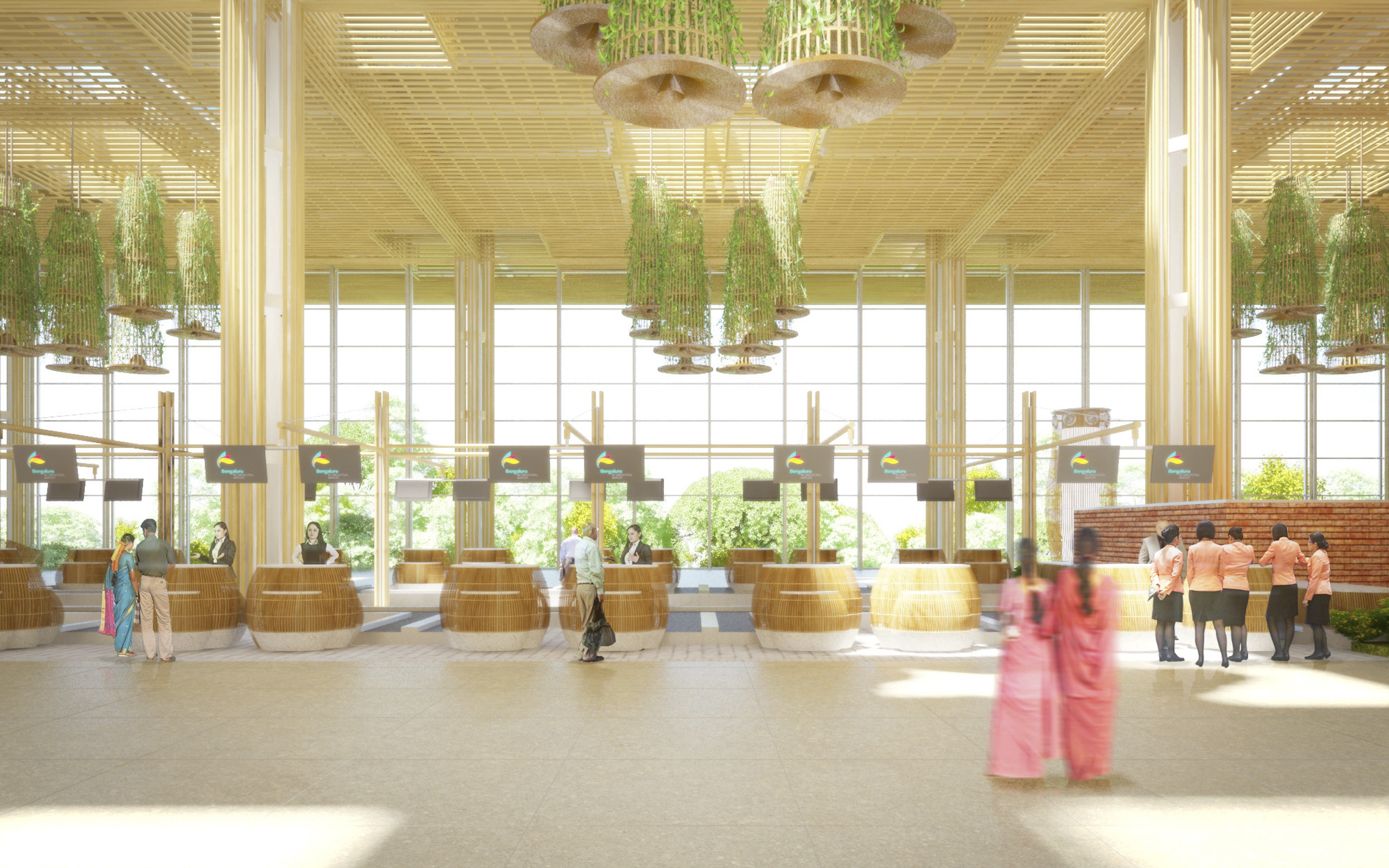
At the center of Kempegowda Airport, with Terminal 2 to its north and Terminal 1 to its southeast, is a 123,000-sm, T-shaped multimodal transit hub, the artery through which the entire complex can be accessed. As if a terminal within a garden isn’t unusual enough, the transit hub features an outdoor retail and entertainment area that the airport has positioned as a new civic center for the city. The gardens from Terminal 2 extend to the hub and its surrounding land. Two lagoons on the hub’s southern side recycle the airport’s stormwater runoff.
Related: BD+C's 2022 Airport Terminal Giants:
• Top 55 Airport Terminal Architecture and AE Firms
• Top 65 Airport Terminal Engineering and EA Firms
• Top 60 Airport Terminal Contractors and CM Firms
India’s Ministry of Civil Aviation estimated that Terminal 2 cost “around” 50 billion rupees to build, or the equivalent of US$604 million. Terminal 2 was designed and constructed to achieve LEED Gold certification. The building is run entirely on renewable energy. The terminal’s second phase, for which no start date has been announced yet, will increase its size to 450,000 sm, and its annual traveler capacity to 40 million.
Related Stories
| Apr 22, 2014
Bright and bustling: Grimshaw reveals plans for the Istanbul Grand Airport [slideshow]
In partnership with the Nordic Office of Architecture and Haptic Architects, Grimshaw Architects has revealed its plans for the terminal of what will be one of the world's busiest airports. The terminal is expected to serve 150 million passengers per year.
| Apr 9, 2014
Steel decks: 11 tips for their proper use | BD+C
Building Teams have been using steel decks with proven success for 75 years. Building Design+Construction consulted with technical experts from the Steel Deck Institute and the deck manufacturing industry for their advice on how best to use steel decking.
| Apr 4, 2014
$25 million Orion Jet Center designed by SchenkelShultz now open
As the centerpiece of the 45-acre campus, which is its first phase of a planned 215-acre mixed-use development, the 18,000 square foot executive terminal facility offers spacious passenger areas, administrative space, an executive suite, rental car kiosk, catering and a cafe.
| Apr 2, 2014
8 tips for avoiding thermal bridges in window applications
Aligning thermal breaks and applying air barriers are among the top design and installation tricks recommended by building enclosure experts.
| Mar 26, 2014
Callison launches sustainable design tool with 84 proven strategies
Hybrid ventilation, nighttime cooling, and fuel cell technology are among the dozens of sustainable design techniques profiled by Callison on its new website, Matrix.Callison.com.
| Mar 20, 2014
Common EIFS failures, and how to prevent them
Poor workmanship, impact damage, building movement, and incompatible or unsound substrate are among the major culprits of EIFS problems.
| Mar 12, 2014
14 new ideas for doors and door hardware
From a high-tech classroom lockdown system to an impact-resistant wide-stile door line, BD+C editors present a collection of door and door hardware innovations.
| Mar 5, 2014
5 tile design trends for 2014
Beveled, geometric, and high-tech patterns are among the hot ceramic tile trends, say tile design experts.
| Mar 1, 2014
Dramatic fractal roof highlights SOM's new Mumbai airport terminal [slideshow]
The terminal merges new technology and traditional regional architecture, notably in the fractal roof canopy that runs throughout the terminal.
| Feb 6, 2014
First look: Gensler ups the ante on airport design with new SFO boarding area
The new terminal features a yoga room, award-winning arts program, and an interactive play area for kids.


